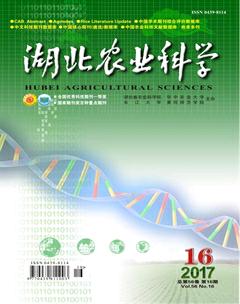快速發展地區經濟—資源—環境系統協調發展研究
程瀟雨+渠麗萍
摘要:鄂州市作為湖北省第一個城鄉一體化試點城市,正在積極、快速推進城鎮化發展,全力打造新型城鎮化城市。通過建立城市經濟-資源-環境(ERE)系統評價指標體系,利用主成分分析法、回歸分析法、隸屬度函數構建ERE系統協調發展評價模型,測算了鄂州市2000-2013年ERE系統的綜合發展水平及協調發展度。結果表明,①鄂州市經濟發展迅速,資源、環境發展相對滯后。②經濟-資源-環境系統協調發展度2000-2013年平均處于中級協調水平且有下降的趨勢,經濟-資源子系統矛盾是阻礙ERE系統協調發展度上升的主要原因。③資源消耗、環境保護問題成為制約鄂州城市發展的關鍵,應根據鄂州市實際情況制定協調發展政策和措施。
關鍵詞:城鎮化;經濟-資源-環境系統;協調發展;工業化;鄂州市
中圖分類號:X24 文獻標識碼:A 文章編號:0439-8114(2017)16-3155-05
DOI:10.14088/j.cnki.issn0439-8114.2017.16.040
Research on Coordinative Development of Economy Research Environment System in Rapidly Development Regions:A Case Study of Ezhou in Hubei
CHENG Xiao-yu,QU Li-ping
(School of Public Administration, China University of Geosciences,Wuhan 430074,China)
Abstract: As the first pilot city of urban-rural integration in Hubei, Ezhou forward the development of urbanization in a positive rapid manner, and to build new-type urbanization city with all its strength. Establishing an evaluation index system for the coordinate developmental degree of ERE system, which reflects the goal of ecological civilization constructing. By means of the PCA method,regression analysis method and membership function,a coordinating development evaluating model of ERE system was established. The comprehensive developmental level of ERE system in Ezhou was calculated from 2000 to 2013. The results showed that firstlyeconomic development was rapid in Ezhou, while environment and resources development were lagging behind. Secondly, the comprehensive developmental level of ERE system was in the intermediate coordination average level during 2000 to 2013, showed a trend of decline in recent years. The main reason is economy and resource system coordinative developmental degree declines. Thirdly, the problem of resources consumption and environment protection became the key to restricting the development of Ezhou, therefore the coordinated development measures and policies should be built according to the real situation of Ezhou.
Key words: urbanization; ERE system; coordinative development; industrialization; Ezhou
城鎮化是經濟發展、生產力提高、社會進步的必然趨勢。改革開放以來,伴隨著工業化進程加速,中國城鎮化經歷了一個起點低、速度快的發展過程,城鎮化率從1978年的17.9%提升到2013年的53.7%,年均提高1.02個百分點。城鎮化作為工業化和現代化的載體與平臺,對促進經濟發展和推進現代化建設發揮了有力的支撐作用[1]。但是城鎮化進程的加快促使人類過度追求經濟的發展,毫無節制的濫用資源,同時對環境也造成較大的破壞。這也導致了經濟-資源-環境(ERE)系統發展的不協調日益明顯。加快經濟轉型和深入發展健康城市化則是解決目前中國經濟發展所面臨一系列資源環境問題的必然選擇。因此,對經濟-資源-環境系統發展的協調性做定量評價,是實現社會經濟效益與資源環境效益雙贏的首要前提。
國外學者對于經濟、資源、環境系統耦合的研究起源于19世紀末,形成了大量理論與實證研究成果。美國學者Grossman等[2]提出了環境庫茲涅茨曲線,表明環境污染與經濟增長呈倒“U”型。Vehmas等[3]較早的對資源環境壓力與經濟增長的脫鉤關系進行了研究。Siebert[4]認為經濟活動規模超過環境所承載限度將會嚴重影響生態系統。國內學者對此也有系統深入的分析,研究內容主要集中在經濟-資源-環境系統耦合的理論、協調耦合度分析、系統動態模擬等方面。馬世駿等[5]構建了社會-經濟-自然復合生態系統觀,揭示了三者之間的相互作用機制。隨后,齊曉娟等[6]、劉承良等[7]、胡彪等[8]、于忠華等[9]、賀晟晨等[10]、秦偉山等[11]從多學科、多尺度研究了經濟、資源、環境系統的協調耦合問題。但研究尺度以省區、城市群(經濟區)為主,研究區域主要分布在發達地區和西部生態脆弱區,對于中部地區中小城市實證研究相對薄弱。近十三年鄂州城鎮化水平年均提高1.5%左右,經濟增速基本保持在12%以上。從速度上衡量,鄂州市屬于中部快速城鎮化地區中較為典型的城市;從區位上看,鄂州市作為湖北省第一批改革開放試驗區,毗鄰武漢,是“1+8”武漢城市圈成員之一。endprint

